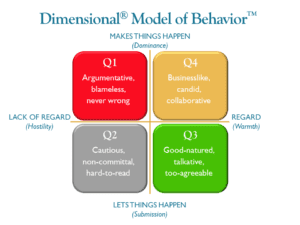This case example portrays a common error made in workplace communication. Can you spot what the mistake is, and the result? You’ll learn how to avoid this misstep as we explore “I” statements vs “you” statements.
When You Ask for Help and Don’t Get It
Meg is the senior accountant for the payroll department of a restaurant chain. The head of the department, Jennifer, is her boss.
The chain has expanded in the last six months, and that has burdened the department. Jennifer had once told Meg that if the company expanded, she would hire additional personnel. At the end of a long, hard day, Meg approaches Jennifer.
Meg:
Jennifer, you said that when we expanded, you would hire another accountant. It’s been six months. Now, whenever it comes up, you seem to change the subject. I’m working late three nights a week just to keep up. Could you please tell me what’s going on?
Jennifer:
Look, Meg, it’s easy for you to say I should just order up another accountant, but things have really tightened up since I said that. I thought my recommendation would sail through. Now, with the expansion, I can’t spend an extra dime over budget. I’ll try to do something about the late hours, but I don’t at all appreciate being hassled about this!
Difficult Conversations with Employees
Meg wasn’t prepared for Jennifer’s flare-up, but she shouldn’t be surprised. It may have been obvious that Meg’s approach was not likely to get the result she wanted. But how should she bring up a sore subject? What could she have done to influence her boss in a Q4 collaborative way?

I Statements Vs You Statements
This is a classic case of using a “you” statement, when using an “I” statement would have been much more effective.
In this example, Meg wanted Jennifer to hire some additional help, as previously promised, to relieve her growing workload.
Accusatory Language
Meg uses accusatory language in making this request. The result is that she gets Jennifer upset. This makes it less likely that she’ll get the additional help she seeks. Plus it doesn’t help her relationship with her boss or her potential for future promotion either.
You Statements
Look at how Meg words her request.
Jennifer, you said that when we expanded, you would hire another accountant. It’s been six months. Now, whenever it comes up, you seem to change the subject…
She used the word “you”, insinuating that her boss was at fault. In fact, she used “you” several times, though once is sufficient for a you statement to be fault-finding.
When you have an issue with another person, using the word “you” in your dialog conveys that they are the cause of the problem. While this may be true, putting it like this can put them on the defensive, causing them to attack back (or withdraw completely). This is not effective for attaining the outcome you desire. You shoot yourself in the foot when using “you” in a conflict dialog.
You vs I Statements
When praising someone, using a you statement is great. It attributes the good work to them, making them feel proud and recognized.
However, when you have a problem situation to discuss, an I statement is much more effective. It enables a productive dialog to discuss getting what you want without antagonizing the other person and torpedoing the conversation out of the gate.
I Statement Examples
For instance, instead of a you (or “your”) statement like this:
Your department is getting its reports out late.
Employ an I statement like this:
I’m concerned about your department running behind on its reports. I’m afraid it’s going to cause delivery problems. What can we do to solve this?
The difference in wording is small. But the effect on driving results can be huge. It’s the difference between potentially antagonizing the other person versus engaging them in a productive dialog to solve the problem.
In the case of Meg and Jennifer above, how might Meg better word her request to increase the likelihood of Jennifer being willing to productively discuss the issue and create an outcome that Meg wants?
“Jennifer, I’m really concerned about the negative effect this staff shortage is having. I’m barely able to keep up. I’m afraid our department will be unable to meet its obligations, or we’ll make a costly mistake. What can we do to avoid that?”
This request for help is far more likely to get Jennifer to respond, rather than simply defend his past behavior. An open, honest discussion without all the baggage of blame could result in Jennifer being more motivated to work together on a solution. For instance, she could make the case again to her own boss to hire someone, but this time, her case could be more effective because of the inclusion of supporting data from Meg.
Here are some other examples of you statements and how, with just a little thought, they can be turned into more productive I statements.
I Statement Example #1
You Statement: You keep on making the same mistake.
Converted to I Statement: I’m feeling frustrated, because this thing has been repeated several times. It’s costing us money, and I don’t know what to do about it.
I Statement Example #2
You Statement: You let me down.
Converted to I Statement: I’m disappointed. I had great expectations for this project, and they have not come to fruition. How can we fix this?
Who Owns the Problem?
A subtle but important difference in I statements vs you statements is in who owns the problem. With a you statement, the implication is that it is the other person’s problem. She is at fault. However, with an I statement, the speaker making the I statement takes on the problem ownership. The problem isn’t the other person. It’s the consequences the behavior is causing. Or, depending on the issue, it can be how the behavior is making others feel. Shifting the focus from the other person to the consequences the behavior is causing moves it from personal attack to productive discussion.
Crafting an Effective I Statement
Here is how to craft an effective I statement in 3 steps:
- Describe the behavior your find unacceptable.
- Point out the adverse consequences of the behavior. This may also include feelings or reactions the behavior causes in you or others.
- Ask for the other person’s help in solving the problem.
Why are I Statements so Powerful?
Let’s answer this from a psychological perspective, as shown in our Dimensional® Model of Behavior™. As you can see above, the Dimensional Model looks at behavior along two axes: action orientation (makes things happen or lets things happen), and people orientation (regard or lack of regard). Both the you and the I statements are high in action orientation. They get the troublesome issue out on the table, which is good. The difference lies in the people orientation. The you statement disregards the other person’s feelings. You statement behavior would be in quadrant 1, which we describe as “tell and do” behavior – action oriented, but with little regard for others.
The I statement shows regard for the other person by couching the issue in a way much less likely to evoke resentment and hurt feelings. I statement behavior is in quadrant 4, “challenge and involve”. A person exhibiting Q4 behavior is action-oriented, and demonstrates high regard for others. The result is that the I statement sets the table for a productive discussion to resolve the issue. Whereas the you statement creates additional barriers that can derail problem solving.
Your Goal with I Statements
Next time you have a difficult conversation where the other person could get their feathers ruffled, try crafting an I statement in advance. You’ll increase your chances of having a productive discussion and making headway on the issue.
Next in Your Leadership Development…
Congratulations on learning to use “I” statements instead of “you” statements. Mastering this is an important tool in your leadership toolbox.
But don’t pat yourself on the back and call it a day! There are other aspects of having an effective interaction beyond what we can cover in a single blog. For instance:
- Jennifer is Meg’s boss. What considerations are important in dealing with someone who has positional power over you, versus a peer or direct report?
- What about Jennifer’s behavior? She procrastinates, is guarded, and avoids change. In our Dimensional Model of Behavior, she shows Q2 behavior. How do you effectively adapt your approach to Q2 behavior vs. other types of behavior you may encounter?
- Using benefits to point out what’s in it for the other person is helpful in motivating people. But how do you know which benefits to use? Are there certain benefits that resonate better with different types of behavior?
To learn answers to these questions and more, visit our leadership learning page. It is chock full of case studies like this one, white papers, synopses of our books, etc.
If you are ready to take the next step as a leader and be able to employ Q4 leadership skills on the job for improved results, then check out our leadership development resources. These include leadership workshops, coaching, and much more that can help you gain more insight into your leadership style and help you become a more effective leader.
Finally, make sure to sign up for our newsletter to keep updated on events and useful content.













